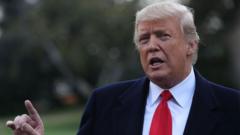The US and China have reached a temporary agreement to lower tariffs, easing the trade war's pressure. The deal, following high-stakes negotiations, suggests a possibility for enhanced cooperation while the lasting impact remains uncertain.
US-China Trade Truce Signals Potential Turning Point

US-China Trade Truce Signals Potential Turning Point
A recent agreement to reduce tariffs could reshape trade dynamics between the US and China, creating ripples in the global economy.
The US and China have confirmed a significant reduction in the tariffs initially imposed during the most recent trade conflict, marking a crucial step toward reconciliation between the two largest economies worldwide. This agreement comes as a relief to various nations, including the UK, which have been caught in the crossfire of escalating trade tensions.
So what changes have been made? Both nations will eliminate some tariffs entirely and postpone others for 90 days, effective by May 14. This will lower additional tariffs on Chinese imports from 145% to 30%, while Chinese tariffs on US products will drop from 125% to 10%. Additionally, China has lifted certain countermeasures, such as halting the restriction on vital mineral exports to the US, which were enacted in response to prior tariff increases. The US retains a 20% tariff component focused on pressuring China to address the illegal trade of fentanyl, a potent opioid.
The timeline beyond the 90 days remains puzzling, as the trade war’s future trajectory has proven unpredictable. However, this agreement is a positive sign of improvement. Even if the suspended tariffs are reinstated, US tariffs would only rise to 54%, and Chinese tariffs would increase to 34%—well below their prior highs. Continued dialogue between US and Chinese officials could pave the way for further agreements, with both sides expressing a desire for cooperation rather than complete disconnection.
The trade relationship between the US and China is vast and varied. As of 2024, the US largely exports soybeans, pharmaceuticals, and petroleum to China, while imports from China predominantly consist of electronics, especially smartphones. The trade volume is uneven—US imports from China total around $440 billion compared to exports of only $145 billion. This imbalance has long irked the Trump administration, which has promoted tariff increases to encourage domestic purchasing and manufacturing jobs.
In the wake of the recent truce, stock markets have responded positively, particularly benefiting major shipping companies affected by prior trade disruptions. Nonetheless, perspectives vary on which side has garnered the upper hand from this agreement. Analysts suggest that while both nations may claim victories, the perception in Beijing could be that the US is retreating from its tough tariff stance, positioning China with a more advantageous negotiating climate. Conversely, the US will continue to assert that the remaining tariffs signal a significant achievement in President Trump's trade strategies.
As global markets react to these developments, the long-term impacts remain to be fully realized. With the foundations for potential collaborations laid, only time will tell if these nations can maintain momentum toward a more stable trading environment.





















